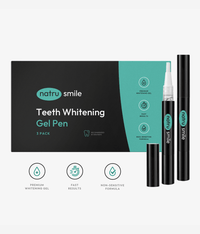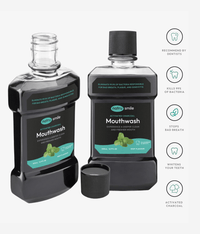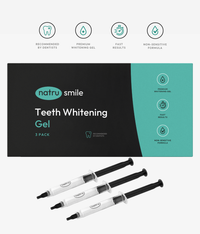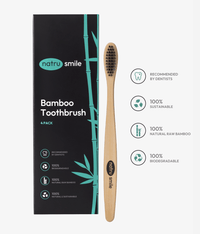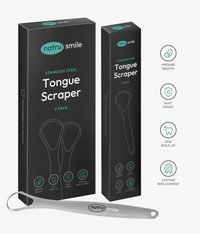
All products are certified by dental expert Dr. Greg Grillo
As more and more people try to whiten their teeth, at-home whitening products are filling the gaps to serve customers who deem professional whitening too expensive or time-consuming. Still, the question remains: which is better for achieving a brighter and whiter smile? This article breaks down everything you need to know about professional vs. at-home teeth whitening.
If you're thinking of whitening your teeth to improve your smile, you aren't the only one. Almost 40 million people in the U.S. alone have done the same.
Of course, the most talked-about procedure is professional (i.e., in-office) whitening. But its high costs and long treatment duration (it can take several hours over multiple sessions) have forced many to look into other opportunities.
Despite improvements that bring costs and appointment times down, plenty of people still need to look for alternatives to dentist-administered whitening—a gap that dozens of brands were quick to fill.
But do these store-bought products actually work?
In this article, we'll give you all the facts to help you decide between professional and at-home teeth whitening.
What Are The Active Ingredients In Whitening Products?
In both in-office whitening treatments and their at-home counterparts, the active ingredient is either hydrogen peroxide or carbamide peroxide. Both of these molecules have bleaching abilities, which can help you get rid of yellow teeth.
Hydrogen and carbamide peroxide easily pass through the porous outer layer of the teeth, known as enamel, to dissolve stains and discoloration. It quickly breaks down complex molecules, such as those that form when food, beverages, and smoking interact with the teeth.
Less complex molecules reflect less light, meaning they don't show staining or discoloration as much (or at all).
This is not a substitute for your regular oral health routine, but it does lead to the appearance of a healthier smile.
Professional Teeth Whitening Vs. At-Home: Which Promises Better Results?
The main difference between in-office and at-home treatments is these molecules' concentration. In-office whitening treatments use higher concentrations—sometimes as high as 43%—than store-bought products.
These higher concentrations allow the dentist to achieve optimal results in a short amount of time, usually in one teeth whitening session that can range from 30 minutes to two hours.
At-home treatments tend to have a concentration ranging between 10 and 22% hydrogen peroxide or carbamide peroxide. This difference limits how effective at-home whitening kits can be.
Still, depending on the severity of the staining and discoloration, at-home treatments can also provide satisfactory results. They just won't be as dramatic and long-lasting as those from professional treatments.
Note: At-home solutions include natural teeth whiteners like baking soda and oil pulling, which also offer results (albeit slower and less dramatic), as well as other oral health benefits.
Main Differences Between Professional And At-Home Teeth Whitening
Aside from the peroxide concentration, there are many differences between professional and at-home teeth whitening procedures.
Cost
For most people, the costs associated with teeth whitening are the most important consideration.
Since there are numerous different kinds of at-home teeth whitening products, the cost is variable. You can find over-the-counter kits for as low as $20, with some effective whitening strips as low as $35 to $40.
High-end whitening kits (e.g., Zoom whitening or the professional-grade Opalescence system) are a bit more expensive, costing hundreds of dollars.
Comparatively, professional teeth whitening costs anywhere from $300 per session to over $1,000.
Put simply, the cheapest possible professional whitening will cost as much as or more than the most expensive at-home treatment.
Effectiveness
As mentioned above, professional teeth whitening treatments have higher concentrations of hydrogen or carbamide peroxide and are, therefore, more effective than at-home solutions. This is especially true in cases where the staining and discoloration are significant.
Another contributor to the efficacy of in-office whitening is the fact that they are performed under dental supervision. Your dentist will take care to protect your gums, tongue, and other oral tissues from the bleaching agents and minimize teeth sensitivity.
At-home treatments come with the risk of exposing these tissues to the whitening product because you are not under any supervision. They can also lead to over-whitening—a common problem that damages the tooth enamel, regardless of the lower peroxide concentration.
Time
The duration of your teeth whitening treatment depends largely on the severity of the staining and discoloration.
In-office solutions are more time-efficient as they use higher concentrations of peroxide that break down complex molecules quickly.
At-home solutions have lower concentrations, which prolong the duration of treatment. Some of these treatments can take up to two weeks for a noticeable difference in your smile.
It is worth noting that at-home solutions are also more convenient—since most are extensions of your regular whitening routine, they don't require additional effort or dedicated time to whiten your teeth.
In-office whitening requires time off work (or a visit on your lunch break), a drive to the dentist's office, and time spent in the chair.
Safety
Many question the safety of whitening—particularly in treatments with such high peroxide concentrations.
The truth is: The American Dental Association considers all teeth whitening options safe as long as you use them as directed.
Your safety is only compromised in the following scenarios:
- Overuse. Overusing whitening products and procedures can erode and damage your tooth enamel.
- Incorrect use. Using the wrong concentrations of bleaching agents or failing to take necessary precautions (e.g., protecting your gums from exposure) can lead to significant dental damage and excessive sensitivity.
- Failure to address underlying dental problems first. If you have a preexisting oral health problem (e.g., cavities, gum disease), whitening before fixing it will only cause additional damage.
The main reason people question its safety is the side effects associated with it. Clinical research repeatedly shows sensitivity after whitening in just about every patient.
That said, this is usually only temporary and can be managed with proper dental hygiene. And newer solutions like LED whitening have been shown to eliminate this side effect in many cases.
Application Tips
When choosing at-home whitening products, a major part of cost-effectiveness is dependent on how you use them. To maximize the results, here are some general tips:
- Do not over-whiten. Whitening toothpaste should only be used for 4 to 6 weeks. You should only use whitening strips twice per year (every six months). Teeth whitening pens are generally safer, but still require additional care. And if you use LED whitening or bleaching trays, do not use other whitening products alongside your treatment.
- Follow instructions on the packaging exactly. Read through the instructions before application. Make sure to measure the whitening gel carefully, avoid contact with your gums and other soft tissues, and follow directions for time of usage as recommended.
- Avoid prolonged usage. Do not leave whitening products on your teeth for longer than specified on the packaging or advised by your dentist.
- Do not use whitening products as a substitute for brushing your teeth. Although white teeth look "healthier," whitening products don't remove plaque, tartar, and debris from your teeth. A thorough brushing is still required for a healthy smile.
If you go the in-office route, you won't have to worry about applying the whitening solution yourself. But you will need to prepare for treatment and follow your dentist's instructions afterward to ensure optimal results.
Here are a few tips to get the most out of your whitening treatment:
- Visit your dentist for an exam prior to whitening. They will check for any existing oral health problems, and determine the best course of action.
- Let your dentist know about your tooth sensitivity. Some patients are more sensitive to bleaching agents than others. If you are naturally sensitive to hot and cold foods, your dentist may adjust the procedure (e.g., using a lower concentration of bleach).
- Follow aftercare instructions to maintain results. Your dentist will advise you on how to keep your teeth white, including dietary restrictions, proper brushing techniques, and potential at-home gel trays.
Longevity
If you're purely looking for the longest-lasting teeth whitening method, Zoom whitening wins by a significant stride. According to both clinical research from the brand itself and personal accounts, this option can last up to two years.
Other in-office whitening solutions can last over one year with proper treatment and upkeep.
At-home whitening kits are cheaper and more convenient, but they only last anywhere from two weeks to six months, depending on usage.
Over-the-counter strips, pastes, gels, and rinses usually range in duration from one week to a month.
Teeth Whitening At Home Vs. In-Office: Which One Is Right For You?
The decision between in-office and at-home teeth whitening will all come down to what makes the most sense for you financially and what fits best into your schedule.
In-office teeth whitening is best if:
- You care most about long-lasting results.
- You want the higher level of safety associated with dental supervision.
- You can afford hundreds (or thousands) of dollars in treatment costs.
- You can easily take work off in the middle of a weekday.
- You have sensitive teeth and require a personalized approach.
- You have preexisting oral health problems that interfere with your immediate ability to whiten your teeth.
At-home teeth whitening is a better option if:
- You are looking for a more affordable option.
- You prefer to do treatments on your own time at home.
- Quick results are important for you (but not permanent ones).
- You don't have any underlying oral health issues that affect your candidacy for treatment.
No matter which route you go, your teeth will surely thank you for the added shine and sparkle!
Want to learn more? These are the questions our customers ask us the most.
Will Whitening Products Improve My Whole Smile?
Whitening products will only improve your whole smile if:
- You don't have a preexisting oral health problem.
- Your teeth are fully intact (i.e., no chips, cracks, gaps).
- You have all your real teeth.
If the above are true, then whitening products and in-office treatments can help improve your smile’s overall appearance. If not, you will need to consider another option, like veneers or dental bonding.
Do Whitening Products Cause Side Effects?
Whitening products have several potential side effects:
- Increased tooth sensitivity
- Pain or discomfort in the gums and mouth
- Irritation of the soft tissues of the mouth, such as lips and tongue
- Dehydration of your teeth after whitening
- Inflammation of the gums
- Hypersensitivity to hot/cold foods following treatment
- Reduced enamel strength due to bleaching agents
- Uneven whitening results, usually occurring when teeth have fillings or other dental work present
- Discomfort caused by hydrogen peroxide used in some treatments
- Stained restorations, including crowns and veneers, that may need replacing after whitening treatments are complete
- Increased risk for oral infections due to weakened enamel
Is It Worth Whitening Your Teeth At The Dentist's Office?
Although some find it tough to justify the cost, those who carry through with in-office teeth whitening treatments love their results. And since they tend to last much longer than other solutions, the long-term benefits make the high immediate cost more than worth it.
Some patients prefer the added safety and convenience of having a professional monitor the entire process. Plus, they can ask questions and receive one-on-one advice throughout their treatment.
What Is The Healthiest Way To Whiten Your Teeth?
The healthiest way to whiten teeth is with a natural whitening method like oil pulling or brushing gently with a baking soda paste. Since teeth are not naturally white, there is an inherent risk in any whitening product or method that uses chemicals to bleach teeth. Although these options are considered safe by the ADA, the absolute safest way to whiten teeth is naturally.
How Many Days Does It Take To Whiten Teeth At Home?
At home, you can expect to see results within 2 to 4 weeks depending on the type of product (whitening strips, trays with gel, etc.) you use. This is much longer than in-office treatments which can often produce results within days (or even hours).
The Bottom Line
If you want to enjoy the benefits of white teeth, you have plenty of options available. Professional in-office treatments offer fast, safe results with longer-lasting effects. But they do come at a higher cost.
Whitening products and home remedies are much more affordable options. But the results are not usually as dramatic or long-lasting. Ultimately, it’s up to you to decide which solution is best for your budget and lifestyle.
In either case, maintaining your new, brighter smile is essential. Good oral hygiene habits and regular visits to the dentist are key for keeping your pearly whites sparkling for years to come!


